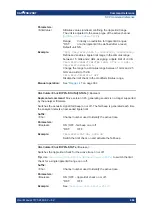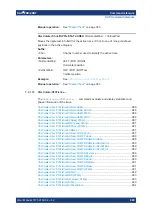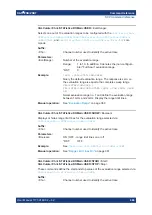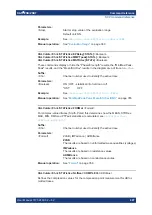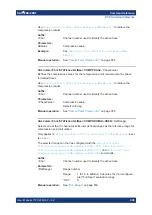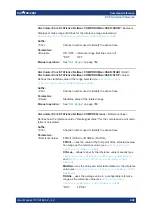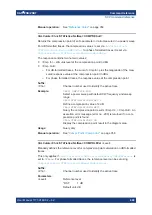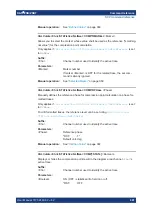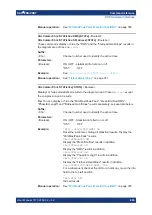
Command reference
R&S
®
ZNB/ZNBT
997
User Manual 1173.9163.02 ─ 62
CALCulate<Chn>:TRANsform:DTFault:PEAK:DATA<FaultNo>
If the active trace of channel <Chn> is a Distance to Fault (DtF) trace and DtF limit
checking is enabled, this query returns the peak data of DtF limit violation <FaultNo>
<FaultNo> must be between 1 and
CALCulate<Chn>:TRANsform:DTFault:PEAK:
. The peak data are returned as value pair
distance, response value
.
Peaks are numbered according to their distance (fault no. 1 has the smallest distance).
Use
CALCulate<Chn>:TRANsform:DTFault:PEAK:STATe
to enable DtF limit
checking and
CALCulate<Chn>:TRANsform:DTFault:PEAK:THReshold
the fault limit.
Suffix:
<Chn>
.
Channel number used to identify the active trace
<FaultNo>
1 ... CALCulate<Chn>:TRANsform:DTFault:PEAK:COUNt?
Example:
Suppose
CALCulate1:TRANsform:DTFault:PEAK:COUNt?
returns 3, then
CALCulate1:TRANsform:DTFault:PEAK:DATA1; DATA2;
DATA3
returns the coordinates of the DtF limit violation peaks.
Options:
R&S
ZNB/ZNBT-K3
Manual operation:
See
CALCulate<Chn>:TRANsform:DTFault:PEAK:STATe
<DtfPeakState>
If the active trace of channel <Chn> is a Distance to Fault (DtF) trace, this command
allows to enable/disable DtF limit checking.
Suffix:
<Chn>
.
Channel number used to identify the active trace
Parameters:
<DtfPeakState>
OFF|ON (0|1)
Example:
*RST; :CALCulate1:TRANsform:DTFault:STATe ON
makes the active trace of channel 1 a DtF trace.
CALCulate1:TRANsform:DTFault:PEAK:STATe ON
enables DtF limit checking.
Options:
R&S
ZNB/ZNBT-K3
Manual operation:
See
CALCulate<Chn>:TRANsform:DTFault:PEAK:THReshold
<PeakThreshold>
If the active trace of channel <Chn> is a Distance to Fault (DtF) trace, this command
allows to set the fault limit for DtF limit checking.
Use
CALCulate<Chn>:TRANsform:DTFault:PEAK:STATe
to enable DtF limit
checking.
SCPI command reference


